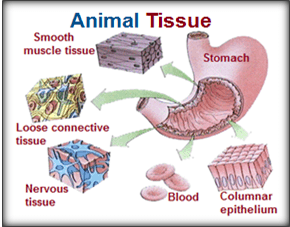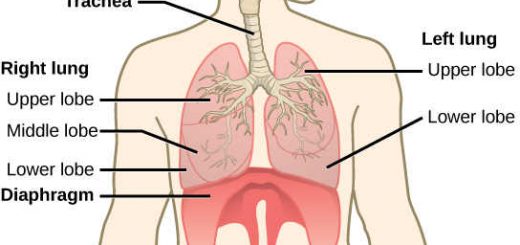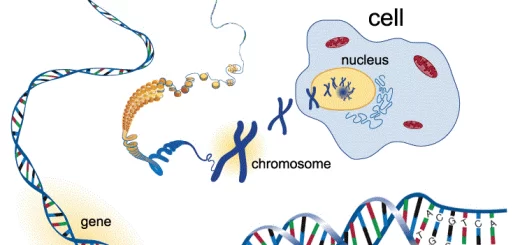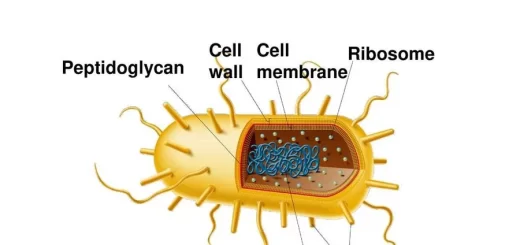Differentiation of cells & Diversity of animal tissues
Animal tissues
Animal tissues can be differentiated into basic types , each of them matches with the function it performs , such as Epithelial tissues , Connective tissues , Muscular tissues and nervous tissues .
Epithelial tissues
They cover the outer surface of the body and line the body’s internal cavities , They are composed of a great number of closely adjacent cells connected by little interstitial ( intercellular ) substance .
Epithelial tissues functions
They perform different functions depending on their site in the body , such as :
- Absorbing the water and digested food, as in the lining of digestive canal .
- Protecting the cells ( which they cover ) from drought and pathogens ( as microbes , as in the skin epidermis .
- Secreting the mucus that makes the cavities they line smooth and moist , as in the digestive canal and trachea .
Types : They are divided into two main types according to their shape and structure , Simple epithelial tissue and Compound ( or stratified ) epithelial tissue .
Simple epithelial tissue
Its cells are organized in one layer , such as Simple squamous tissue, Simple cuboidal tissue and Simple columnar , Simple squamous tissue consists of one layer of flattened cells such as the lining ( endothelium ) of the blood capillaries and the wall of alveoli in the lungs .
Simple cuboidal tissue consists of one layer of cuboidal cells such as the lining of the kidney tubules, Simple columnar consists of one layer of columnar cells such as the lining of the stomach and intestines .
Compound ( or stratified ) epithelial tissue
Its cells are organized in several layers such as the stratified squamous tissue, The stratified squamous tissue consists of several layers of compact cells above each others and its surface layer is squamous , such as the tissue of skin epidermis .
Connective tissues
They are made up of some what distant cells that immersed in an intercellular substance , they may be fluid , semi-solid or solid, They are divided according to the kind of the intercellular substance into three types which are Connective tissue proper , Skeletal connective tissue and Vascular connective tissue .
Connective tissue proper
It gathers between being fairly solid and quite elastic, Function : Connecting the different body tissues and systems with each other , So , it is widely spread such as the dermis of skin and mesentries .
Skeletal connective tissue
Its intercellular substance is solid in which calcium deposits in case of bones, Functions : Supporting the body such as the bones and cartilages .
Vascular connective tissue
its intercellular substance is fluid, Function : Transporting the digested food and excretory substances , such as the blood and lymph .
Muscular tissues
They are made up of cells known as muscular cells or muscle fibres , which are distinguished from other body cells by their abilities of contraction relaxation , So , this helps the organism to move, They are divided into three types which are Smooth muscles , Skeletal muscles and Cardiac muscles .
Smooth muscles
They consist of unstriated involuntary muscle fibres, They present in the wall of viscera such as wall of digestive canal , urinary bladder and blood vessels .
Skeletal muscles
They consist of striated voluntary muscle fibres, They are usually connected with the skeleton , such as the muscles of arms , legs and trunk .
Cardiac muscles
They consist of striated involuntary muscle fibres , They contain intercalated discs that bind the muscle fibres together and make the heart beats in a rhythmic way as one functional unit, They present in the heart wall only .
Nervous tissues
They consist of cells called nerve cells ( or neurons ), The nerve cell is the building and functional unit of the nervous system .
Function : Receiving both the internal and external sensory stimuli and conduct them to the brain and spinal cord , then transmitting the motor impulses to the effector organs ( muscles or glands ) , Therefore , nervous tissues are responsible for different activities of body organs .
Stem cells
Stem cells are the cells that have the ability to form any other type of specialized cells, such as muscle cells, liver cells, nerve cells and skin cells, according to specific environmental treatments at the laboratory, Stem cells are formed during the early stages of the fetus development .
Role of stem cells in treating of intractable diseases :
They are used to produce dopamine substance used to treat some nervous diseases as Parkinson disease, They are transplanted to give cardiac muscle cells as a compensation about the decrease of secretion of this hormone by pancreas for diabetes patients.
Cell fractionation
Cell fractionation is one of the modern technologies used to :
- Study each type of different cells forming a certain tissue .
- Study the different organelles forming one type of cells and this includes the site of these organelles , their functions and their components .
- Study the biological macromolecules like enzymes .
- Study the biological processes occur inside the cell .
Ways of using cell fractionation technology :
Cell fractionation technology depends on using ultracentrifuge apparatuses to separate cell organelles at different speeds depending on the different densities of these organelles .
Histology, Molecular structure of the cell membrane, Cell function & structure
Vesicular transport of Macromolecules across the cell membrane, Endocytosis & Exocytosis
Types of Transport through cell membranes, Active transport, Simple & Facilitated diffusion





super
Thank you for your comment